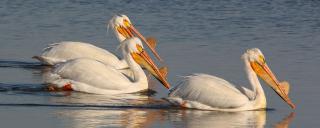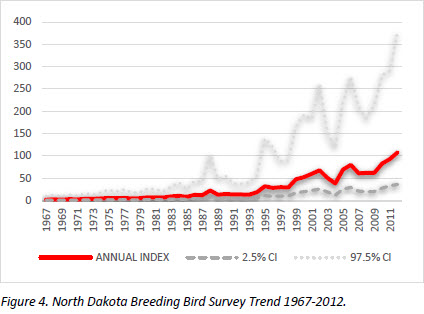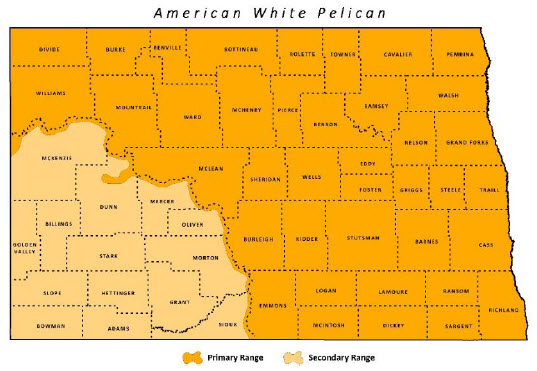
White Pelican
| Scientific Name | Pelecanus erythrorhynchos |
|---|---|
| General Description | L 62”, WS 108”, 16 lb. A very large white bird with black flight feathers, elongated orange-yellow bill and feet. |
| Status | Occurs in North Dakota from April to October. Peak breeding season mid-April to late July. |
| Abundance | Common. |
| Primary Habitat | Isolated, barren islands or peninsulas in large lakes or reservoirs for breeding; lakes and semi-permanent wetlands for foraging. |
| Federal Status | Migratory Bird. |
| Reason for Designation | Chase Lake National Wildlife Refuge hosts the largest colony of breeding white pelicans in North America with an estimated 1/3 to 1/2 of the entire population of pelicans nesting here. Since 2005, small colonies (less than 500 nests) have been documented at several other sites. A “responsibility” species. Moved from a level I to a level II because populations appear stable to increasing. Moderate Concern by Waterbird Conservation for the Americas. |
Locations and Conditions of Key Habitat
Preferred Habitat
Pelicans nest in colonies on barren islands or peninsulas in large lakes or sometimes on rivers. Island substrate of gravel, sand, or soil is preferred, with little to no vegetation. Commonly nest with other colonial birds such as double-crested cormorant, gulls and terns. The areas on which they nest are often greater than50 km from where they forage. Primary prey items include fish (e.g. carp, chubs, shiners, and catfish), salamanders, frogs, or crayfish. Foraging occurs in shallow waters, 0.3-2.5 m., of marshes, lakes, and rivers. Sovada et al. 2013 found selection against temporary and seasonal wetlands and rivers for foraging. It is only during times of spawning that game fish species are suspected to be taken due to the pelican’s shallow water foraging habit.
Key Areas and Conditions for White Pelicans in North Dakota
Chase Lake National Wildlife Refuge in western Stutsman County hosts the world’s largest colony of breeding white pelicans. Other colonies are now located in the Van Hook Arm area of Lake Sakakawea, Willow Lake in Rolette County, Evanenko WPA and Lake Nettie in McLean County, and Rosemount WPA in Ward County. Key foraging sites have not been identified.
Problems Which May Affect this Species
Habitat
The destruction or degradation of key foraging wetlands and associated prey species could affect pelican populations.
Other Natural or Manmade Factors
The recent outbreak of West Nile virus (WNV) in North America may have negatively affected the pelican population in North Dakota. In 2003, half of the pre-fledged pelicans died from WNV. Mortality of pelican chicks from WNV appears to be an additive mortality factor. Other diseases that could potentially impact large colonies include Newcastle’s disease and avian botulism. Perceived competition for fish resources with sport and commercial fisheries. Primary mammalian predators include fox and coyote, with coyote harassment being a potential cause of the recent pelican abandonment. Human disturbance or intrusion of the nesting colonies during the courtship period and initial incubation may cause abandonment. Expanding oil and gas development in North Dakota increases risk of oilfield contamination of wetland habitat. Some mortality from collisions with power lines and wind turbines.
Research and Survey Efforts
Current Research or Surveys
- Rocky Mountain Bird Observatory (ND SWG T-40-R) is conducting a statewide inventory of colonial and semi-colonial waterbird populations and identifying key sites for breeding colonies in North Dakota. The American White Pelican is one of 29 target species. The project was initiated in March 2014.
Previous Research or Surveys
- Northern Prairie Wildlife Research Center (ND SWG T-7-R) explore factors that may lead to colony abandonment or reduced productivity. The project was initiated in 2005 and continued through 2007, and final report was provided in 2007. In 2004 and 2005, adult pelicans in this and other colonies abandoned their nesting effort believably by 1) coyote depredation or disturbance, 2) anthropomorphic disturbance, 3) disease, 4) weather, 5) food resource shortage, or 6) a combination of factors. Pelicans at the Chase Lake colony may be experiencing effects from climate change causing earlier spring arrival and onset of breeding activity. Scientific Investigations Report 2013-5105 (Sovada 2013, Sovada et al. 2014).
- More than 2,000 young white pelicans are banded each year at Chase Lake NWR. In the 1970s, studies on food habits, production and survival, and movements and mortality were conducted.
- Numerous published reports and gray literature on this species throughout its range and in North Dakota.
Additional Research or Surveys Needed
Continue to monitor the influence of WNV and other diseases on the population and colonies.
- Demographic or life history information is lacking.
Population and Trend Estimates

- North American Waterbird Conservation Plan Population Estimate: >120,000 breeders
- NPPWCP BCR11 Population Estimate: >32,203
- 10-year (2000-2009) average number of nests at Chase Lake NWR: 13,500
- North Dakota BBS Trend: see figure 4
- Survey-wide BBS Trend 1966-2012: 5.12
Management Recommendations
- Protect nesting colonies from human intrusion during courtship and initial incubation stages.
- Fence peninsulas if coyote predation becomes a problem.
- Utility development should follow the guidance of “Reducing vian Collisions with Power Lines” including marking power lines and creating an Avian Protection Plan.
- Wind industry companies should collaborate with the American Wind and Wildlife Institute for responsible wind development.
Monitoring Plans
Monitor new, existing, and historic colonies. The NPPWCP has identified the basic elements of how a regional/continental waterbird monitoring program should be structured. Waterbird monitoring should follow recommendations of the Waterbird Conservation for the Americas and North American Bird Conservation Initiative ‘Opportunities for Improving Avian Monitoring’.
2005-2015 Progress
The American White Pelican was moved from a Level I to a Level II Species of Conservation Priority due to stable population and increasing breeding range. White pelicans are establishing small but new breeding colonies in North Dakota. Efforts to identify additional breeding colonies are underway. Although new colonies are forming, the white pelican remains at-risk primarily due to the overall limited number of colonies in North America (less than 50). Several State Wildlife Grant Projects (T2-9-R, T-18-R, T-27-HM) have contributed to habitat enhancement of wetlands for white pelicans

Note: A listing of works consulted when compiling the information on this page may be found in the 2015 State Wildlife Action Plan.
